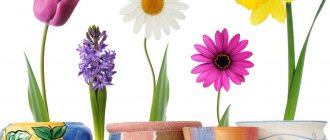"Indoor plants in preschool educational institutions"
- March 29, 2017
International and All-Russian competitions
All-Russian competition of pedagogical excellence “Methodological piggy bank of a kindergarten teacher”
All parents want their child to feel as comfortable in kindergarten as at home. Indoor plants contribute well to this. They create a homely feeling in kindergarten groups and just look beautiful. But indoor plants in a kindergarten are not only an element of the interior, but also an element of wildlife in the lives of little people. However, not all plants can be kept in garden groups. Some of them are prohibited and even poisonous. You will learn how to understand our many green friends from this article. Benefits of indoor plants Properly placed plants have a good effect on the emotions and health of children, relieve fatigue, and cause joy. In addition, perennials create freshness and soften dry indoor air. This is especially important during the heating season. With the help of plants, it is quite possible to improve the psychological climate and hygienic environment in the group. For kindergarten premises, plants that produce phytoncides - light, natural substances that have bactericidal properties - are of great importance. We know that babies are very sensitive to various infections; they often carry and spread bacteria and viruses. To do this, they just need to cough or sneeze. Perennials with phytoncidal properties improve the air environment in groups. Requirements for the design of a green corner
You need to follow certain rules when creating a corner of nature:
- flowers should be beautiful and eye-catching
- plants must belong to the ecosystem in which the kindergarten is located. Usually these are low-maintenance indoor flowers. Even a child can follow them.
- perennials should be presented in several copies so that children are able to get an idea of certain plants.
Choosing indoor plants for kindergarten
For a preschool institution, you need to select plants that will not harm the kids. If children in kindergarten are taught how to care for flowers, this will help teach them to work. Houseplants are excellent at absorbing harmful substances and dust from the air. Scientists have proven that in a room with plants, the number of harmful microorganisms is reduced by 2 times.
Indoor flowers in garden groups are a good way to purify the air. The main requirement for them is safety. It is better to choose unpretentious plants so that even children can care for them. You need to start introducing perennials from early preschool age. The main task is to develop children's cognitive interest in the world of plants and flowers.
Indoor plants allowed in kindergarten
The following indoor plants are allowed to be planted in preschool institutions:
- aloe, crassula, peperomia, japonica aucuba. They release phytoncides into the air and help children avoid contracting seasonal colds.
- Chlorophytum crested. It perfectly absorbs carbon dioxide from the air and is well suited for rooms with a large number of people.
- fuchsia, begonia, azalea. These plants have distinct flowers, stems and leaves. Thanks to this, kids will be able to study their structure.
- geogenanthus, money tree, gasthenia. These perennials have large leaves, children will wipe and water them.
- Kalanchoe
- Chinese rose
- gloxinia
- Crassula
- coleus, caladium bicolor, hyposthes with multi-colored leaves. These plants are quite bright, and children will be interested in watching their growth, which helps develop their powers of observation.
Houseplants prohibited in kindergarten
The following types of plants cannot be kept in gardens:
- ficus, dieffenbachia. It is forbidden to touch them; the juice of the leaves contains poison.
- all types of cacti. Plants have thorns and thorns, and children can be seriously injured if they touch them out of curiosity.
- oleander, lilies. If a child comes into contact with these flowers, undesirable consequences are possible. Their smell may well cause a severe headache.
- geranium. Surprisingly, this plant, familiar to everyone since childhood, can provoke an asthma attack or cause allergies, as it releases essential oils.
Choose indoor plants for your kindergarten wisely, following our advice.
The children will gain skills in caring for flowers and will become more attentive and independent. Indoor plants are the best solution for preschool institutions. It is best to look at poisonous indoor plants in the photo in order to know them not only by name, but also by sight. After all, if some poisonous plants are well known to everyone, others are not known to everyone.
Dieffenbachia
Dieffenbachia, with its elegant, attractive appearance, is a very common indoor plant. It can often be found in offices, apartments, schools and kindergartens.
Indoor plants in kindergartens are considered not only interior elements, but also air purifiers. This is also a good opportunity to get acquainted with the world around us, learn to observe and care for plants. This makes our children kinder and more responsible.
The selection of indoor plants should be carried out with the ability of children to care for flowers.
Aloe.
An unpretentious plant. For successful growth, aloe should be kept in bright rooms. Prefers a cool winter (10-15 degrees), but can tolerate higher temperatures. During this period, the plant should not be watered abundantly; in summer, aloe needs quite abundant watering without completely drying out the root ball. Aloe is not demanding on soils - ordinary garden soil mixed with coarse sand is suitable. The plant is propagated by rooting apical cuttings or planting the resulting lateral shoots.
Asparagus, or asparagus.
The plant should be provided with sufficient lighting, but protected from direct sunlight. Asparagus prefers a cool winter (10-15 degrees). If the air temperature in the room is not lower than 18-20 degrees, then spraying can be used during the heating season. Watering is plentiful in summer and moderate in winter. Asparagus is propagated by sowing seeds or dividing the bush.
Impatiens, or impatiens, or flame.
Feels good in strong diffused light. It should be watered abundantly, not allowing the root ball to dry out. In winter, water less intensively, because Overmoistening at low temperatures leads to rotting of the roots and death of the plant. Room temperature is quite suitable for overwintering these plants. Impatiens are propagated only vegetatively, by cuttings.
Begonia.
Begonias develop best in strong, but diffused light and can be damaged by direct rays of the midday sun. Watering in summer is plentiful, in winter it is significantly reduced, but without allowing the root ball to dry out completely. The soil for begonia should be light, permeable to air and water. In winter, it needs to be kept in a cool, relatively dry place. Begonias propagate by leaf cuttings and division of rhizomes.
Dracaena.
Caring for dracaena is easy. Dracaena is light-loving, but you should not keep it in direct sunlight. Reacts well to regular spraying with warm water. Excessive watering in winter should be avoided. Overwinters at temperatures not lower than 15 degrees. Dracaena propagates by cuttings.
Kalanchoe.
Grows well in bright rooms. In summer, watering is plentiful. Needs a cool winter with moderate watering as the root ball dries completely. Kalanchoe propagates by cuttings or shoots.
Coleus, or nettle.
Coleus is light-loving, but with too much direct sunlight, the leaves become discolored. Requires regular pinching, otherwise the lower part of the stems is exposed. In winter, it is advisable to keep it in a cool environment - at a temperature of 12-15 degrees - and limit watering, preventing the root ball from completely drying out, and in summer - feed regularly. The plant is easy to take cuttings.
Maranta.
Grown in warm rooms. Intense lighting should be avoided. Watering is regular. During the winter dormancy period, arrowroot may lose some of its leaves and needs to limit watering. The plant is propagated by division or cuttings.
Fern (nephrolepis).
Good lighting and watering are necessary to prevent the coma from becoming waterlogged or drying out. It is necessary to spray the plant with water at room temperature during the heating season. They reproduce using tiny spores by dividing the bush.
Pelargonium or geranium.
Growing pelargoniums indoors is not difficult: care includes regular watering and fertilizing with complex mineral fertilizers. Old plants need periodic pruning. Large-flowered pelargoniums also need to be pruned after flowering, otherwise the plants will become very elongated. Pelargoniums are propagated by cuttings.
Ivy.
Does not suffer from direct sunlight, has shade tolerance, and can grow in diffused light in the depths of the room. Propagation by ivy cuttings is possible at any time of the year. In summer the plant requires abundant watering, in winter - moderate.
Sansevieria, or pike tail.
An unpretentious plant. It can grow in the shade, but develops better in a bright place. Does not require spraying. Watering is limited in winter. The higher the wintering temperature, the less watering should be. Propagation by division and using leaf cuttings.
White-flowered Tradescantia.
It is unpretentious. This plant blooms very rarely in a room. With a lack of light, the leaf pattern fades. Tradescantia can withstand low air temperatures. Watering is regular. Tradescantia is easy to take cuttings.
Violet, or Saintpaulia violet flower.
In the warm season, the plant is protected from direct sunlight. In winter, the air temperature should not be lower than 16-18 degrees. Sudden changes in temperature and drafts should be avoided. If violets are overwatered, the bases of the leaves rot and the plant dies. Propagation is carried out by rooting leaf cuttings.
Ficus rubber plant.
An unpretentious plant, but you need to remember that in response to a sharp change in growing conditions: temperature, humidity, watering regime, the ficus begins to shed its leaves. Ficus also does not like prolonged temperature drops below 15-16 degrees. Ficus is propagated by cuttings.
Chlorophytum.
An unpretentious plant. They can grow under different temperature and light conditions. In winter, the plant cannot be flooded. Chlorophytum is propagated by rooting daughter rosettes. This unpretentious plant is especially valuable due to its ability to cleanse the atmosphere of harmful gaseous impurities.
Cyperus.
Caring for cyperus consists of regular replanting (in spring and summer), fertilizing and abundant watering. The plant can overwinter at a temperature of 12 degrees, or it can feel great in a warm room. Propagated by division and rosettes.
But this plant is very poisonous. Dieffenbachia juice has a paralyzing effect, leading to a burning sensation of the tongue, the appearance of swelling and blisters, and temporary paralysis of the vocal cords. Getting juice into the eyes can cause severe conjunctivitis.
Oleander
Oleander attracts with its beautiful soft pink flowers. But, despite its beauty, this plant is one of the most poisonous plants. All parts of the oleander are poisonous, but especially its juice and seeds. A flowering plant should not be placed in the bedroom: the floral aroma causes severe headaches and dizziness. Under no circumstances should you chew its leaves.
If an animal eats its leaf, it will die as a result of convulsions and disruption of the heart.
Monstera
Monstera, captivating with its magnificent appearance, is a favorite plant for offices, institutions and schools. But this beautiful flower is very poisonous. If the juice gets into the mouth, it will cause blisters and severe burning of the tongue, lips and throat.
Azalea or rhododendron
Azalea is a common and favorite flower. But she is very poisonous.
Substances contained in the plant, when entering the human body, disrupt the functioning of the muscular and nervous systems, as well as the heart.
Cyclamen
The delicious cyclamen has poisonous tubers that are especially dangerous for dogs and cats. When they are eaten, the animal develops diarrhea and vomiting. Possible death.
Hydrangea
Hydrangea will not leave anyone indifferent. Its magnificent inflorescences evoke admiration. But it turns out that all parts of this delicious plant contain dangerous substances. Ingestion of plant juice provokes severe sweating, impaired blood flow, stomach pain, muscle weakness, and nausea.
Calladium
Chewing calladium leaves leads to swelling of the larynx and tongue and difficulty breathing. The plant has an adverse effect on kidney function.
Syngonium
This beautiful vine is quite poisonous. Chewing its leaves leads to vomiting, swelling of the tongue and upset stomach.
Spathiphyllum
Eating spathiphyllum leaves by animals causes nausea and stomach upset.
Clivia
Blooming clivia attracts all eyes. But if you handle it carelessly, it will cause vomiting, diarrhea and excessive salivation.
It can even cause paralysis.
Ivy
Ivy contains many toxic substances that, when entering the human body, irritate the skin and cause diarrhea. In case of severe poisoning, allergies, hallucinations, and respiratory arrest are possible.
Ficus
Ficus trees are especially popular. But their stems and leaves contain dangerous substances that cause irritation and redness of the skin, blisters and allergies.
Euphorbia
Various types of milkweed are quite often grown in apartments. But they all contain poisonous milky juice, which is irritating to human skin and mucous membranes. It causes disruption of the digestive tract and leads to nervous disorders.
Euphorbia white-veined, or ribbed
White-veined milkweed, which due to its appearance is often confused with a palm tree, grows in apartments, offices, hospitals, and schools. But this plant should be cared for with caution: its milky sap is very poisonous.
Euphorbia
Euphorbia belongs to the Euphorbia family and, like all other members of the family, secretes a poisonous milky sap. If a drop of juice gets on the mucous membrane, it will lead to the appearance of a long-term non-healing ulcer. If the juice gets into the eyes, it causes inflammation and sometimes temporary blindness. Eating leaves by animals causes vomiting, diarrhea, seizures, and sometimes death.
Euphorbia Mile
The milky sap of the plant causes burning, skin damage, and blisters. Juice that gets into the eyes causes temporary blindness. If the juice gets into the mouth, vomiting, abdominal pain and severe diarrhea occur.
Severe poisoning can lead to dizziness, convulsions, poor circulation and delirium.
Euphorbia tirucalli
Euphorbia tirucalli attracts with its exotic appearance. But you should be extremely careful with this plant. It is the most poisonous among the euphorbias. If the juice enters the body it leads to death.
Having studied the poisonous indoor plants in the photo, you will know when working with which indoor plants you need to use gloves and make sure that the juice of this plant does not get into your mouth or eyes.
If there are small children in the house, then pots with such flowers should be placed in a place inaccessible to them, or it is better to give them to neighbors who do not have children.
It is not recommended to keep poisonous plants in living areas, especially in bedrooms, as they release toxic substances into the air, albeit in small quantities.
What flowers should be in a corner of nature in the older group?
Since plants in a corner of nature are replenished from the youngest group, their composition to the older group will be very diverse:
- common geranium;
- fuchsia;
- begonia everblooming;
- primrose;
- balsam;
- camellia;
- Chinese rose;
- coleus;
21 Feb
2022 Interesting materials:
How to change an ad on Farpost? How can I change my ad? How to change the scroll area in Excel? How to change page scroll area in Excel? How to change the cover of a published Instagram video? How to change the cover of a VK track? How to change the cover of a video in Inshot? How to change wallpaper on Google? How to change the appearance on Steam? How to change the Welcome window in Windows 10?





